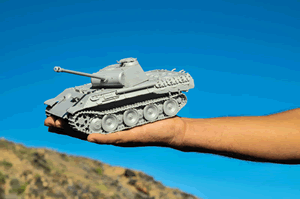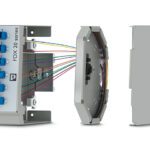Connector Designs for Miniaturization of Military Electronics
Military organizations throughout the world are working hard to lighten the load soldiers carry into battle; connector and cabling designs may offer solutions for miniaturization of military electronics.
 There is a great sense of urgency in military organizations worldwide to modernize their operations. According to National Defense Magazine, there is an “innovation gap” that is putting the soldier of today in peril. For troops to have the best shot at surviving and winning wars, they must carry a collection of equipment that includes, among other things, communication devices, weapons, ammunition, and batteries. The rugged environment in places like Afghanistan, where troops trek miles up into the thin air of the mountains, has made it imperative that scientists in government and industry find ways to lighten loads that can reach 100 pounds; every ounce of equipment carried must improve communications, agility, and lethality for soldier survivability.
There is a great sense of urgency in military organizations worldwide to modernize their operations. According to National Defense Magazine, there is an “innovation gap” that is putting the soldier of today in peril. For troops to have the best shot at surviving and winning wars, they must carry a collection of equipment that includes, among other things, communication devices, weapons, ammunition, and batteries. The rugged environment in places like Afghanistan, where troops trek miles up into the thin air of the mountains, has made it imperative that scientists in government and industry find ways to lighten loads that can reach 100 pounds; every ounce of equipment carried must improve communications, agility, and lethality for soldier survivability.
Many “Future Soldier” programs like the US Department of Defense’s Nett Warrior, India’s F-Insas, Italy’s Soldato Futuro, Poland’s Uhlan 21, Finland’s Finnish Warrior, and Australia’s Land 125 have been established to address these very issues. These military organizations pay attention to what they call SWaP – size, weight, and power.
SWaP
Weight is a particularly vital consideration for the dismounted soldier, who typically carries more than 80 pounds. The mandate put forth by military organizations is to reduce this weight by 25%. Given that each soldier wears a backpack and body armor and carries weaponry and ammunition, finding that 20 pounds of overall weight reduction requires rethinking the design and packaging of many types of electronic and communication equipment. For instance, night vision, targeting systems, smart phones, GPS, tactical computers, and communications equipment could be integrated into a very functional and reliable subsystem, requiring an array of cables, harnesses, and connectors. All of this equipment is necessary, so manufacturers must work with component partners to find ways to lose small amounts of weight in each component to achieve this 20-pound weight loss.
The miniaturization of component electronics and connectivity plays a vital role in reaching this goal. Connectors must be rugged enough to withstand dirt, grime, and weather, but should be small, light, and easy to use in tense situations. Connections must be made in fractions of a second, and often they must be made when wearing gloves, so push-pull connector designs that lock instantly rather than requiring twists are the logical solution. Communications devices must work 100% of the time, whether radios to talk with commanders or remote control devices for robots that peek around corners and report back electronically. Therefore, designers for military equipment should consider connectivity holistically with the design of their devices. This can help them limit the number and size of connectors and reduce cabling as well.
When searching for the perfect connector for a military application, several factors should be considered, including weight, size, functionality, data speed, sterilization, and waterproof ratings.
Weight
Maintaining a lightweight design is extremely important when dealing with portable units. Some connectors provide weight savings of up to 75% compared to the standard core connectors.
Size
As part of efforts to reduce the weight each soldier must carry, militaries and their prime contractors are also striving to shrink the physical size of components as well. Highly functional connectors and cable assemblies can be reduced in size by 45% compared with the older connector solutions and prevent interference between power and signal. Smaller connectors that maintain functional standards allow designers to shrink the size of their boxes; even millimeters make a difference to a soldier in the field.
Even so, engineers must be careful about reducing size. Going too small could lead to problems for soldier usability. Many commercially available connectors are too fragile for use by soldiers who are often in critical situations, and others are simply too small to be handled with gloves. The key to selecting the right-sized connector may come down to looking closely at the density of the pins and the way the connector protects against interference in the smallest, lightest ways. This pin density allows the connector to be smaller, reducing both size and weight of the device and, just as importantly, the cable solution required.
Functionality
Ruggedness is an extremely important factor in functionality. Connectors used in extreme conditions should be able to withstand an onslaught of sand, water, chemicals, and other exterior factors. They also need to withstand rough use over time. It is important that well-used connectors withstand over 4Nm of torque, and overmolded assemblies should withstand 40kg of pull (break-away) force.
Increasing pin density is also important, as this allows a single miniature connector to do the job of two, three, or more larger, less-compact connectors. The ideal connector can have up to 24 pins and perform several functions – transmission of power, Ethernet, HDMI, etc. – without interference. Manufacturers have recently made strides toward creating connectors with a large number of pins that function optimally without interference.
Connectors should be easy to mate or unmate even when using gloves and durable enough to be functional through a high number of mating cycles. This ensures the electrical performance remains the same; anything less and a soldier risks finding a failure in his equipment, which could be a matter of life and death.
Data Transfer
With increasing demands for both power and secure data transfer, military considerations for miniaturization include the ability to move data quickly and without interference. Data-transfer speed is impacted by the connector, the cable selected, and the assembly itself. It is more important than ever to give yourself enough time to test connector/cable combinations to ensure that you achieve the data speed you require. As connectors get smaller, cable selection gets trickier due to size and assembly restrictions. Suppliers should be able to provide evidence of achieving certain data speeds and supporting protocols such as USB, Ethernet, or HDMI; suggest appropriate cable designs; or provide fully assembled connector/cable solutions.
Sterilization
In the harsh, extreme battlefield environment, it is crucial that connectors be sealed, whether mated or unmated, in order to keep out sand, dirt, water, and chemicals. Just as important is the ability to clean and often sterilize (ABC principle: atomic, bacterial, chemical) these connectors without damaging them. All connectors can be sterilized but not necessarily with all sterilization methods. For example, some can be washed, some can be gamma-sterilized, and others can be placed in an autoclave. If a connector needs sterilization, make sure you know the exact method of sterilization acceptable for the miniature solution you select.
Waterproof IP Ratings
Most connector manufacturers self-test their products. This means that while the rating “IP68,” for example, might be placed on a connector, the test that the manufacturer used to obtain such a rating might be different than the test used by another manufacturer. Such tests include immersing the connector in different levels of water for different amounts of time. When researching connectors, it is important to question the testing methods, as one brand’s IP68 rating may have been obtained differently than another brand’s.
Military connectors should also be IP68-rated both mated and unmated to reduce the need for protective caps. An IP68 rating for an unmated connector is a distinct advantage to the soldier.
Today’s militaries continue to invest in the latest technologies and are turning to prime contractors and off-the-shelf suppliers to bring that technology to them. The companies which bring smaller, lighter equipment to the table will be given additional opportunities to prove their devices will work on the battlefield. Paying attention to the connection solution and the latest trends in rugged connector miniaturization will help companies meet military demands and make it into the field.
Author Wim Vanheertum is product manager at Fischer Connectors.






